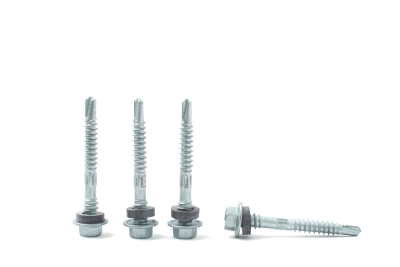What Is a Drilled Screw?

A drilled screw is a type of screw designed to be inserted without the need for pre-drilling or threading. It drills its hole as it is screwed into the material, simplifying the installation process.
Typically, fastening a screw requires a pre-drilled hole that matches the screw’s thread. This process is known as threading.
With drilled screws, threading is unnecessary, allowing for fastening without a pre-made threaded hole. The screw drills its hole, securing the materials together.
Uses of Drilled Screws
Drilled screws are commonly used in steel frame construction, providing a reliable fastening solution.
The screw mustn’t rest on the upper sheet metal when its drill part penetrates the lower sheet metal. This prevents the upper sheet metal from lifting and creating a gap during tightening, which could lead to fastening failure.
Principle of Drilled Screws
Drilled screws come in various types for different applications, each with its unique design and principle.
1. Head Shape: Pan
The pan head is prevalent for its excellent cold formability, making it a common choice for drilled screws.
2. Head Shape: Hexagonal
Hexagonal heads offer high torque transmission and are less prone to camming out, ideal for larger-diameter screws.
3. Head Shape: Flat
Flat heads enhance the appearance of the fastened area, as they do not protrude post-fastening.
4. Head Shape: Countersunk
Countersunk heads allow screws to be easily sunk into harder materials, thanks to the ribs formed on the seat surface.
5. Head Shape: Truss
Truss heads have a large diameter, providing a strong hold on the fastened material.
6. Thread Design: Tapping
Tapping threads are widely utilized for their ability to fasten lightweight steel frames effectively.
7. Thread Design: Machine
Machine threads ensure a secure hold even in thin base materials, reducing the screw’s outside diameter and tightening torque.
Types of Drilled Screws
The appropriate drill screw type should be selected based on the plate’s thickness.
1. For Thin Plates
Designed for fastening thin steel plates (1 to 1.2 mm), offering high holding power.
2. For Standard Plate Thickness
Commonly used for plates 2.3 to 4.5 mm thick, balancing screwability and holding power.
3. For Medium and Thick Plates
Ideal for plates 4.0 to 6.5 mm thick, with a part of the thread machined to reduce screw-in torque.
4. For Thick Plates
Suitable for plates 6 to 13 mm thick, featuring a notched thread to form a cutting edge.
How to Select Drilled Screws
Drilled screws are primarily made from stainless steel or carbon steel, each offering distinct advantages.
1. Stainless Steel
Available in martensitic or austenitic grades, stainless steel screws offer high corrosion resistance. Martensitic stainless steel is quenchable for added strength, while austenitic is preferable for its superior corrosion resistance.
2. Carbon Steel
Made from high-quality aluminum-killed steel, carbon steel screws are known for their impact strength, abrasion resistance, and tensile strength.
Structure of Drilled Screws
For wood or hardboard installations, drilled screws with reamers or pilots are available.
1. With Reamer
The reamer widens the hole drilled by the screw, featuring two winged blades at the drill section’s end. It functions effectively in soft materials like wood, bursting open when encountering hard materials.
2. With Pilot
The pilot section, located at the screw’s tip, includes a smooth portion extending from the drill section, facilitating the fastening of thick materials.